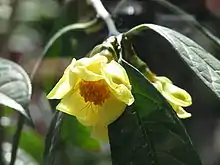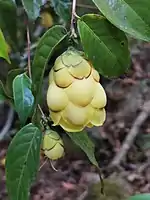Camellia petelotii
Camellia petelotii is a species of plant in the family Theaceae.[2] It is found in China (endemic in the Guangxi Zhuang Autonomous Region in southern China) and Vietnam. It may be called the golden camellia and synonyms include C. chrysantha and Camellia nitidissima. The golden camellia originated 170 million years ago, it is a first-class nationally protected plant in China.[3] The golden camellia is extremely demanding on the growth environment, and its genes are extremely difficult to replicate, once transplanted, it will die or genetically mutate.[4] Therefore, in 1986, the Golden Camellia National Nature Reserve was built in Fangcheng, Guangxi, with a total area of 9195.1 hectares.[5]
| Golden camellia | |
|---|---|
 | |
| Scientific classification | |
| Kingdom: | Plantae |
| Clade: | Tracheophytes |
| Clade: | Angiosperms |
| Clade: | Eudicots |
| Clade: | Asterids |
| Order: | Ericales |
| Family: | Theaceae |
| Genus: | Camellia |
| Species: | C. petelotii |
| Binomial name | |
| Camellia petelotii (Merr.) Sealy | |
| Synonyms | |
| |
It is threatened by habitat loss. It originates from southern China and Vietnam where it has been used to make tea; it has also been propagated as a garden plant for its waxy yellow flowers, which are unusual in a camellia. It is endangered in the wild, but favored as a garden plant.
Description
Camellia petelotii is a shrub or small tree growing up to 5 meters in height.[6]
Uses
According to the research and experiments of The Institute of Medicinal Plant Development (China)-Guangxi Branch and some other Chinese medicine research institutions in Guangxi, Golden camellia tea has the functions of preventing cancer, inhibiting tumor growth, lowering blood pressure, lowering blood lipids, lowering cholesterol, preventing atherosclerosis, delaying aging and other health effects as improve the body's immune.[7]
Gallery
References
- Orel, G.; Rivers, M.C. (2018). "Camellia petelotii". IUCN Red List of Threatened Species. 2018: e.T191436A1981489. doi:10.2305/IUCN.UK.2018-1.RLTS.T191436A1981489.en. Retrieved 16 November 2021.
- POWO: Camellia petelotii (Merr.) Sealy (retrieved 24 March 2021)
- "廣西特色食品—金花茶介紹" (in Chinese). 中華民國對外貿易發展協會. Retrieved 16 November 2022.
- "廣西特色食品—金花茶介紹" (in Chinese). 中華民國對外貿易發展協會. Retrieved 16 November 2022.
- "广西防城金花茶自然保护区简介" (in Chinese). 广西壮族自治区生态环境厅. Retrieved 16 November 2022.
- "Camellia petelotii (Merrill) Sealy, Kew Bull". Flora of China. Retrieved 17 November 2022.
- "廣西特色食品—金花茶介紹" (in Chinese). 中華民國對外貿易發展協會. Retrieved 16 November 2022.
Further reading
- Sunyatsenia 7: 19 1948.
- The Plant List
- International Camellia Society
- Global Trees Campaign
External links
 Media related to Camellia petelotii at Wikimedia Commons
Media related to Camellia petelotii at Wikimedia Commons Media related to Camellia nitidissima at Wikimedia Commons
Media related to Camellia nitidissima at Wikimedia Commons




